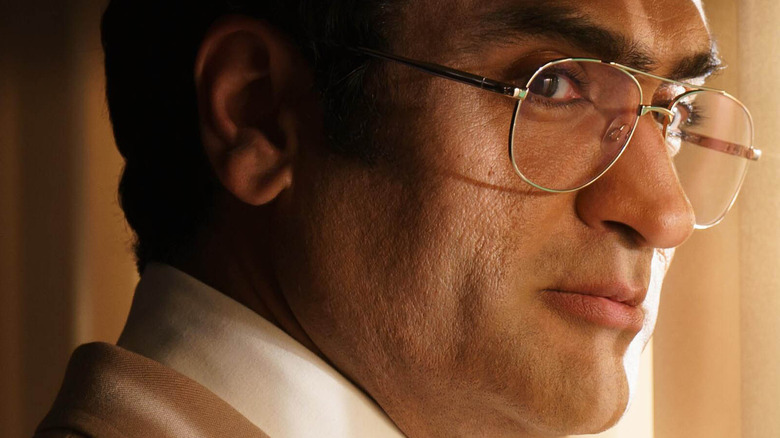Kumail Nanjiani Approached His Welcome To Chippendales Character By Channeling His Own Insecurity
After a year of critically acclaimed hits across several genres ("The Bear," "The Old Man," and "The Patient"), Hulu will try to keep the streak alive with a true crime series. Premiering on November 22, "Welcome to Chippendales" tells the story of the rise and fall of the notorious Chippendales strip club, as well as its equally notorious founder, Steve Banerjee.
The Chippendales strip club has a much more sordid history than you might expect. It was founded in Los Angels in 1979 by Banerjee, and its signature presentation of cuffed and collared beefcake, along with its choreography by Emmy-winner Nic De Noia (Murray Bartlett), made it a household name. But Banerjee's drive for success had a dark side. After multiple arsons, civil lawsuits, and murder-for-hire plots, it all came crashing down.
Banerjee is played by Kumail Nanjiani, who's most famous for his work as a standup comedian. Even though it's not his first weighty role–he previously starred in the autobiographical dramedy "The Big Sick" and played Kingo in Marvel's "Eternals"–Steve Banerjee is still a big departure from his usual work. Nanjiani spoke about how he approached the role, but first, who was Steve Banerjee?
The real Steve Banerjee was definitely complicated enough to fuel a TV series
The show is going to cover most of this, but if you want a head start, here's a quick bio on Steve Banerjee without spoiling too much of the plot.
Somen "Steve" Banerjee" was born in 1946 in Bombay, India. He emigrated to the United States sometime in the 1960's. His first attempts at entrepreneurship were running a Mobil station and starting a backgammon club, but both failed. Then, as seen in the trailer for "Welcome to Chippendales," Banerjee had a revolutionary idea: he would start a strip club marketed towards women. So, he bought an abandoned strip club in Los Angeles called "Destiny II" and renamed it "Chippendales." He then hired choreographer Nic DeNoia, and soon the two built an $8 million-a-year business (per Get Bengali).
Banerjee was proud of his success and flaunted his wealth with designer clothes, expensive cars, jewelry, and more. Yet despite his flashiness, Banerjee was deeply unsatisfied with his physical appearance. Banerjee was overweight, and the media noticed–as recently as 2021, The New York Post referred to him as "paunchy." It doesn't take a degree in psychology to figure out why a man so insecure about himself would create a business that would glorify certain types of male bodies.
All of this adds up to a deeply flawed and complicated character to portray. For Nanjiani, it required drawing on his own personal experience.
Kumail Nanjiani related to Steve Banerjee on a personal level
Nanjiani talked about the character in an interview with E! News. He started by giving a breakdown of Steve Banerjee's emotional state, describing him as someone who's not in touch with his feelings. "I think a lot of men are disconnected from their inner lives and have a hard time admitting their emotions, even labeling what they're feeling," Nanjiani said. "I think that then can come out in aggressive, even violent ways, if you're not processing the grief you're feeling, if you're not processing your sadness, or your fear."
Nanjiani continued that he interpreted Banerjee to be someone who's not comfortable in their own body, which is something he personally relates to. In 2020, he told Men's Health that transforming his body to play Kingo gave him body dysmorphia. To channel this while playing Banerjee, Nanjiani walked in a stiff, robotic manner, which he described as like Robocop but "not as cool." The effect worked onscreen but also gave him a painful knot in his shoulder.
It remains to be seen whether "Welcome to Chippendales" will win over critics like Hulu's other recent offerings have, but it sounds like it has all the ingredients to be a success.


